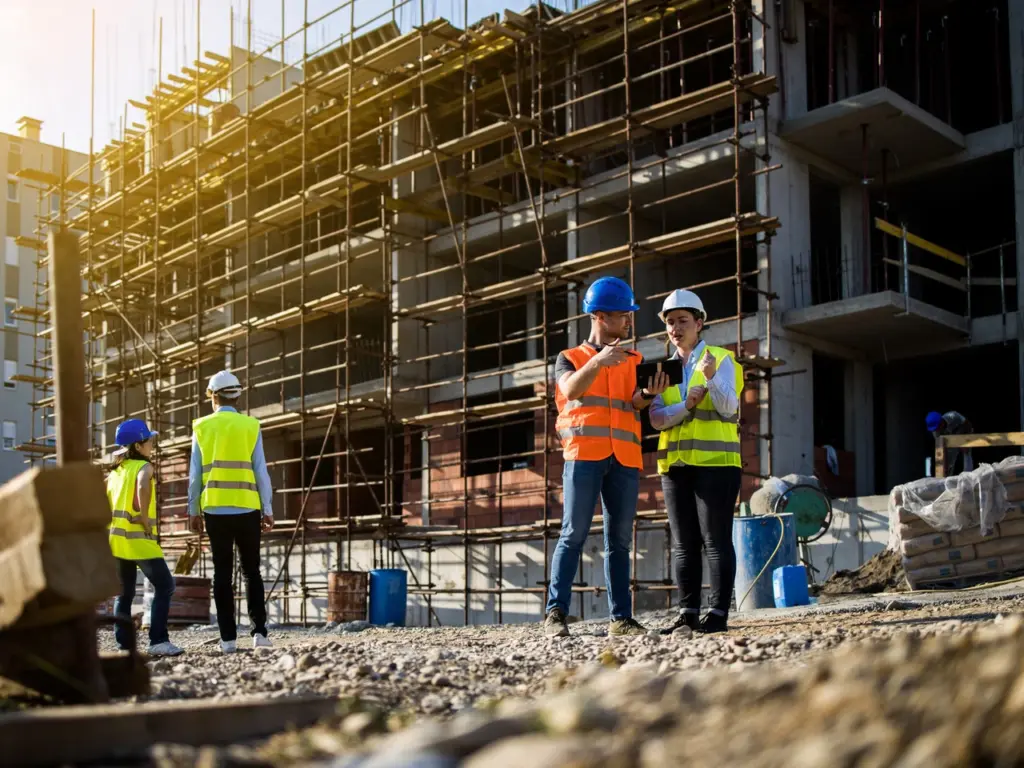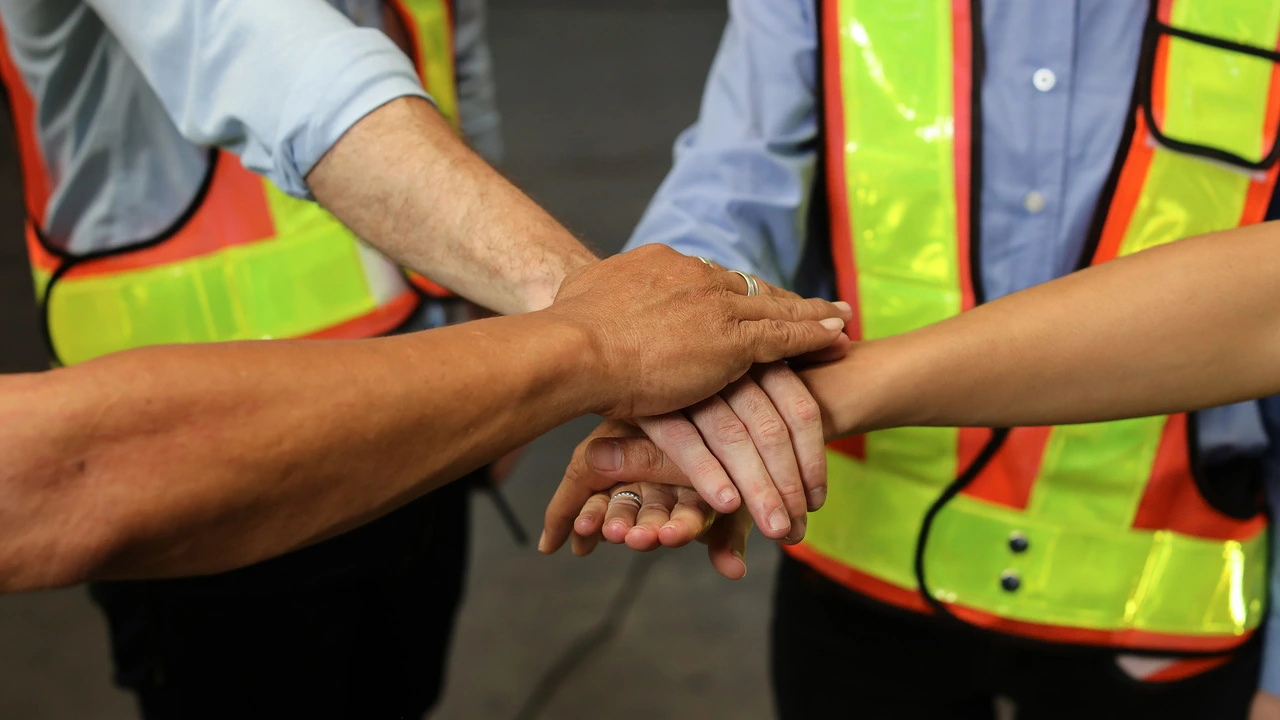How can the construction industry become more efficient and collaborative? The answer lies in the concept of integrated construction, a revolutionary approach that seamlessly merges planning, design, and construction into a single cohesive process.
In Canada, this method is gaining traction as a means to eliminate inefficiencies and promote stronger collaboration among all stakeholders involved in a project. By integrating these critical phases from the outset, Canadian construction companies are not only optimizing resource allocation but also enhancing the overall quality of their projects.
In this article, we’ll examine the core principles of integrated construction, highlight its essential benefits, and explore how this approach is transforming the landscape of the construction industry in Canada. Read on to learn more!
Understanding Integrated Construction

Integrated construction is a transformative approach that highlights collaboration among all stakeholders involved in a construction project, from planning through to implementation. Here are the key aspects of integrated construction:
Collaborative Mindset
Integrated construction encourages an environment where architects, engineers, contractors, and clients work together seamlessly, breaking down the barriers often found in traditional construction methods.
Early Stakeholder Involvement
In this approach, key stakeholders are involved early in the project, leading to:
- Improved decision-making.
- Enhanced communication.
- Mitigation of risks.
Optimization of Resources
By adopting an integrated approach, Canadian construction companies can:
- Utilize resources more effectively.
- Reduce project costs.
- Improve timelines, ensuring projects are completed efficiently.
Technology Integration
The use of innovative technology, such as Building Information Modeling (BIM), supports the integrated construction process by:
- Facilitating real-time collaboration.
- Streamlining the construction process.
- Enhancing project delivery.
Sustainability Focus
Integrated construction aligns with sustainability goals, allowing for:
- More efficient use of materials.
- Reduction of waste throughout the construction process.
- A commitment to environmentally friendly practices.
Complex Project Management
Given the diverse landscape of Canada, integrated construction is particularly beneficial for managing complex projects. This approach enables:
- Comprehensive planning and execution.
- Effective coordination among various trades and components.
- Successful delivery of large-scale projects, such as multifamily developments or commercial facilities.
By embracing integrated construction, companies can set new standards in the sector, proving that collaboration and innovation can lead to superior project outcomes.
The Importance of Integrating Planning in Canadian Construction

Integrating planning into the construction process is important for ensuring project success. As the construction industry continues to evolve, effective planning emerges as a foundational element that shapes the overall execution of projects. Here are the key reasons why integrating planning is crucial in construction:
Enhanced Coordination
By integrating planning with design and construction phases, all stakeholders—such as architects, engineers, and contractors—are aligned from the beginning. This coordinated approach helps:
- Minimize conflicts and misunderstandings.
- Ensure that all parties are aware of project timelines, objectives, and expectations.
Streamlined Processes
Integrated planning allows for a more streamlined construction process, which can lead to:
- Improved efficiency in project execution.
- Faster decision-making is needed as stakeholders are involved in every step of the planning and design process.
Risk Mitigation
Planning integration enables teams to identify potential risks early in the construction process, leading to:
- Proactive solutions that can address issues before they escalate.
- Enhanced ability to navigate regulatory requirements and ensure compliance with industry standards.
Resource Optimization
With effective integrated planning, resources such as labor, materials, and equipment can be utilized more efficiently, resulting in:
- Reduced project costs through careful budgeting and resource allocation.
- Better management of project timelines, leading to on-time delivery.
Sustainability Goals
In Canada, where environmental considerations are critical, integrated planning allows construction projects to align with sustainability objectives. This involves:
- Incorporating eco-friendly materials and practices from the outset.
- Reducing waste and energy consumption during the construction phase.
Client Satisfaction
Ultimately, integrating planning enhances the client experience by ensuring that their needs and expectations are met throughout the project lifecycle. This leads to:
- Greater transparency in communication.
- Increased trust and confidence in the project team.
Support for Complex Projects
In a diverse and dynamic construction landscape, integrated planning is especially important for managing complex projects, such as:
- Multifamily residential developments.
- Senior living facilities or commercial properties require detailed coordination among various divisions.
How Integrated Design Practices Shape Canadian Construction

Integrated design practices are transforming the construction industry in Canada by promoting collaboration and improving project execution. Here’s how these approaches impact the industry:
Holistic Approach
Integrated design provides a comprehensive view of the construction process, ensuring that all stakeholders are involved from the beginning. This includes:
- Collaboration among architects, engineers, and contractors, creates an environment where expertise is shared.
- Interdisciplinary teams, including project managers and superintendents, work together to solve complex challenges.
Enhanced Efficiency
By integrating design with construction management, companies can achieve significant improvements in efficiency:
- Streamlined communication reduces delays, as information flows seamlessly between team members at the construction site and the company’s headquarters.
- Faster problem-solving allows managers to address issues quickly, minimizing disruption to the project schedule.
Informed Decision-Making
Integrated design practices empower teams to make informed decisions based on real-time data, leading to:
- Better resource allocation, optimizing the use of labour and materials in various industrial settings.
- Effective risk management enables experts to identify and mitigate potential issues before they impact project timelines.
Sustainability Focus
These practices also support sustainability initiatives by:
- Incorporating eco-friendly materials and technologies into architectural designs helps reduce the overall environmental impact of construction.
- Improving energy efficiency, creating buildings that meet the highest standards for sustainability.
Customization and Client Satisfaction
Integrated design enables companies to provide tailored solutions that meet client needs, resulting in:
- Personalized projects that reflect client vision and requirements.
- Increased satisfaction, as clients see their ideas and preferences incorporated into the final design.
The Role of Technology in Enhancing Integrated Construction

Technology has become a foundation of integrated construction, greatly changing how projects are planned, designed, and executed. Its impact is seen in several key areas that enhance collaboration, efficiency, and sustainability. Here’s how technology is reshaping integrated construction:
Enhanced Collaboration
Technology fosters seamless communication among all stakeholders involved in a construction project. This is critical for integrated construction, where collaboration is key.Building Information Modeling (BIM)
- Definition and Benefits: BIM allows architects, engineers, and construction managers to create digital representations of projects, ensuring alignment among all parties from the outset.
- Real-time Collaboration: Stakeholders can access and modify the model, facilitating effective communication and reducing errors.
Cloud-based Project Management Software
- Features: These platforms enable real-time updates and data sharing, helping project teams coordinate their efforts and respond quickly to challenges.
- Accessibility: Team members can access information from any location, ensuring that everyone is on the same page throughout the construction process.
Streamlined Project Management
Effective project management is crucial for the success of integrated construction, and technology plays a significant role here.Data Analytics
- Performance Tracking: Advanced analytics tools help managers track project performance metrics, allowing for timely interventions and informed decision-making.
- Predictive Analysis: By analyzing historical data, teams can anticipate challenges and adjust plans proactively.
Resource Optimization
- Labour and Material Allocation: Digital tools assist in effectively allocating labour, materials, and equipment, minimizing waste and enhancing productivity on-site.
- Cost Management: Improved resource management leads to better budget control and reduced project costs.
Support for Sustainability
In an era where sustainability is increasingly important, technology helps support eco-friendly construction practices.Energy Modeling Software
- Optimization Tools: These tools allow designers to optimize energy use, leading to lower carbon footprints and operational costs in buildings.
- Regulatory Compliance: Using energy modeling ensures that projects meet local sustainability regulations and standards.
Eco-friendly Materials Tracking
- Sourcing and Usage: Advanced systems ensure that sustainable materials are sourced and used appropriately throughout the project lifecycle.
- Lifecycle Analysis: Technology helps assess the environmental impact of materials, guiding better choices during construction.
Innovative Design Solutions
Technological advancements are opening up new possibilities in architectural and engineering designs.3D Printing
- Rapid Prototyping: This technology allows the rapid prototyping and construction of components, significantly reducing lead times.
- Complex Designs: 3D printing facilitates complex designs that traditional construction methods may struggle to achieve.
Augmented and Virtual Reality (AR/VR)
- Visualization Tools: These technologies enhance visualization, allowing clients and stakeholders to experience a project before construction begins.
- Feedback and Adjustments: Clients can provide feedback on designs, facilitating better decision-making and minimizing changes during the construction phase.
Improved Safety Protocols
Safety remains a top priority in construction, and technology greatly enhances safety measures.Wearable Technology
- Health Monitoring: Devices equipped with sensors can monitor workers’ health and safety in real time, providing alerts to managers about potential hazards.
- Data Collection: Wearables can gather data on working conditions, helping to identify trends and areas for improvement.
Drones
- Site Surveying: Drones can survey construction sites, offering aerial views and data that help identify safety risks and ensure compliance with regulations.
- Progress Monitoring: Drones provide real-time updates on project progress, allowing for better oversight and management.
The Benefits of Integrated Construction

Integrated construction represents a modern approach to building that combines planning, design, and execution into a cohesive process. This methodology offers numerous advantages that can enhance project outcomes and improve overall efficiency. Here are some of the key benefits of integrated construction:
1. Improved Collaboration Among Stakeholders
One of the most significant benefits of integrated construction is enhanced collaboration among all parties involved, including general contractors, real estate developers, and trade partners.
- Streamlined Communication: The integrated approach fosters open lines of communication, ensuring that all stakeholders, from employees to foremen, are aligned from the start of the project. This reduces misunderstandings and misalignment that can lead to costly delays.
- Shared Goals: By committing to a unified process, stakeholders can work toward a common objective. This teamwork enhances efficiency and promotes a sense of community among all participants in the construction project.
2. Increased Efficiency and Reduced Waste
Integrated construction helps streamline processes, resulting in improved efficiency and minimized waste throughout the construction lifecycle.
- Optimized Resource Allocation: By integrating various project phases, teams can allocate resources more effectively, ensuring that labor, materials, and equipment are utilized optimally, thus reducing excess.
- Reduced Rework: A unified process minimizes the likelihood of errors that often necessitate rework. This is crucial in construction, where rework can be both costly and time-consuming.
3. Enhanced Project Visibility and Control
Technology plays a critical role in integrated construction, providing tools that enhance visibility and control over the project.
- Real-time Data Access: Tools such as Building Information Modeling (BIM) offer comprehensive views of the project, allowing professionals to monitor progress, identify issues early, and make informed decisions.
- Tracking and Reporting: Integrated systems provide detailed tracking of project timelines, budgets, and resources. This enables managers to maintain control and adjust plans as needed, ensuring the project operates smoothly from start to finish.
4. Improved Risk Management
Integrated construction allows for better risk identification and management, ensuring that potential issues are addressed proactively.
- Collaborative Problem-Solving: By involving all stakeholders in the planning process, teams can identify risks early and collaborate on effective solutions, reducing the impact of unforeseen challenges.
- Informed Decision-Making: Access to real-time data and insights empowers project managers to make informed decisions that mitigate risks and keep the project on track.
5. Enhanced Sustainability
Sustainability is a growing concern in the construction industry, and integrated construction promotes eco-friendly practices.
- Sustainable Design Practices: Integrated construction encourages the use of sustainable materials and design strategies that minimize environmental impact.
- Energy Efficiency: By integrating energy modeling tools, teams can design buildings that optimize energy use and reduce long-term operational costs.
6. Cost Savings
The integrated construction approach often leads to significant cost savings, making it an attractive option for clients and stakeholders.
- Reduced Project Costs: By minimizing waste, reducing rework, and improving efficiency, integrated construction can lower overall project costs.
- Predictable Budgeting: Enhanced project visibility and control allow for more accurate budgeting and forecasting, reducing the risk of unexpected expenses.
7. Leadership and Professional Development
Integrated construction fosters a culture of leadership and professional development within the industry.
- Commitment to Excellence: Companies that embrace integrated construction demonstrate a commitment to high standards, often resulting in award-winning projects that stun clients and the community.
- Employee Growth: With an emphasis on collaboration and innovation, employees gain valuable experience managing complex projects, enhancing their skills and career opportunities.
8. Extensive Network of Trade Partners
The integrated construction approach facilitates collaboration with a wide range of trade partners, enhancing the overall quality of the project.
- Coordinated Efforts: By involving trade partners from the pre-construction phase, teams can ensure that specifications are met, and the project runs smoothly.
- Shared Resources: Collaboration fosters a network that allows for the sharing of resources and expertise, ultimately benefiting all stakeholders involved.
9. Community Engagement
Integrated construction encourages companies to engage with the communities in which they operate.
- Local Opportunities: By considering local labour and materials, construction companies can support the eastern community and promote economic development.
- Celebrating Success: Successful projects often lead to celebrations that strengthen community ties and promote goodwill among residents and stakeholders.
10. Privacy and Compliance
Integrated construction also emphasizes the importance of privacy and compliance in project management.
- Data Security: Advanced technology solutions help ensure that sensitive project information remains secure, providing peace of mind to all parties involved.
- Regulatory Adherence: A focus on specification verification ensures that projects comply with local regulations, reducing the risk of legal complications.
By incorporating these benefits, integrated construction not only enhances the efficiency and effectiveness of projects but also fosters a more collaborative and sustainable construction industry.
Final Thoughts
The Canadian approach to integrated construction is transforming the construction industry by promoting collaboration, enhancing efficiency, and prioritizing sustainability.
By merging the planning, design, and construction phases, stakeholders can work together more effectively, minimizing waste and reducing costs.
The integration of advanced technologies further supports this process, allowing for better resource management and improved project visibility.
As this process continues to gain traction, it sets new standards for project execution and community engagement, eventually leading to superior results.
Frequently Asked Questions
What is integrated construction in the Canadian context?
Integrated construction in Canada is an official methodology that combines planning, design, and fabrication processes to enhance project outcomes. Here are the key aspects:
- Collaboration: This approach promotes teamwork among architects, engineers, and contractors, allowing for practical solutions from the project’s start.
- Efficiency: By aligning project phases, it verifies that all steps are coordinated, reducing delays and minimizing waste.
- Transparency: Open communication among stakeholders promotes trust, enabling quicker decision-making in pursuit of project goals.
- Sustainability: It usually incorporates sustainable practices, ranking high in priority for environmentally conscious projects.
- Quality Improvement: Continuous collaboration ensures that all components are aligned, leading to superior outcomes.
Integrated construction in Canada enhances efficiency, quality, and sustainability through collaboration and a verified process.
What are the benefits of integrated construction?
The benefits of integrated construction are significant, making it a sought-after approach for many projects in Canada. Here’s a breakdown:
- Reduced Costs: By minimizing delays and streamlining processes, integrated construction can lead to significant savings during fabrication.
- Improved Timelines: Projects are completed faster due to better coordination among teams, ensuring practical timelines that meet needs.
- Enhanced Quality: Continuous collaboration ensures all aspects are verified for quality, leading to superior outcomes.
- Increased Innovation: The integration of diverse expertise encourages innovative solutions to challenges.
- Better Risk Management: Early identification of risks through collaborative planning allows teams to address concerns effectively.
Integrated construction offers benefits, including cost savings, improved timelines, and enhanced project quality.
How does integrated construction differ from traditional construction methods?
Integrated construction differs significantly from traditional methods, focusing on collaboration rather than sequential task execution. Here’s a comparison:
- Collaborative vs. Sequential: Integrated construction involves all stakeholders from the start, while traditional methods engage participants mainly during specific phases, making verification more challenging.
- Flexibility: The integrated approach allows for adjustments throughout the project, whereas traditional methods can be rigid once initiated.
- Communication: Integrated construction emphasizes open dialogue, while traditional methods may experience fragmented communication.
- Problem-Solving: Issues are collectively addressed in integrated construction, whereas traditional methods rely on individual departments.
- Project Control: Integrated construction allows for better control over project variables, while traditional methods often lead to segmented oversight.
Integrated construction fosters a more cohesive and responsive approach compared to the segmented traditional methods.
What role does technology play in integrated construction?
Technology is crucial in integrated construction, enhancing collaboration and efficiency throughout the project lifecycle. Key technological aspects include:
- Building Information Modeling (BIM): BIM enables real-time collaboration and verification, facilitating effective visualization and design changes.
- Project Management Software: Integrated tools streamline communication and document sharing, ensuring alignment in pursuit of project goals.
- Data Analytics: Advanced analytics can predict outcomes and verify progress, helping teams make informed decisions.
- Virtual Reality (VR) and Augmented Reality (AR): These technologies enhance design reviews, allowing for practical experiences that aid understanding.
- Mobile Technologies: Mobile apps allow on-site teams to access information instantly, improving decision-making and reducing delays.
Technology enhances integrated construction by facilitating collaboration, verifying details, and enabling better outcomes.
How can companies implement integrated construction practices?
Organizations can successfully implement integrated construction practices by adopting strategic approaches. Here’s how:
- Culture Shift: Foster a collaborative culture that values teamwork and practical problem-solving among stakeholders.
- Training Programs: Provide training on integrated construction principles to ensure team members have the necessary skills.
- Choose the Right Tools: Invest in technology and software that support integrated construction, such as BIM and project management tools, to verify project status.
- Pilot Projects: Start with smaller projects to test integrated methods, allowing for adjustments and practical learning before scaling up.
- Stakeholder Engagement: Involve all relevant stakeholders early to build relationships and encourage collective ownership.
Implementing integrated construction practices requires a cultural shift, strategic training, and stakeholder collaboration to effectively pursue the benefits of this approach.

